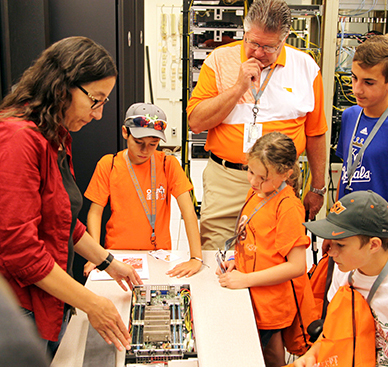
Growing Oklahoma's Supercomputing Power
Author: Jamie Hadwin, Oklahoma State University
---------------------------------------------------------------------
High performance computing (HPC) became a national priority with the issuance of a 2015 executive order to create a federal strategy for HPC research, development and deployment through the National Strategic Computing Initiative.
Luckily for Oklahoma State University, it is already ahead of the HPC curve. Not only has OSU emerged over the last decade as a leader in national HPC community building efforts, but the university is also preparing to install a new supercomputer named Pistol Pete.

OSU’s High Performance Computing Center (HPCC) facilitates a wide range of advanced computing research services to researchers throughout the state, including a series of progressively more powerful supercomputers.
OSU’s current supercomputer, Cowboy, was funded by a 2011 National Science Foundation Major Research Instrumentation (MRI) grant, making it, at the time, the largest externally funded supercomputer in the state.
Today, installation of the Pistol Pete supercomputer is underway following a second NSF MRI grant awarded in 2015. HPCC staff are busy working with construction teams to remodel a new data center to house the supercomputer system, which should be operational later this year.
“In computer years Cowboy is old,” says Dana Brunson, OSU assistant vice president for research cyberinfrastructure and director of the HPCC. “Cowboy can do 48 trillion calculations per second. I expect us to be able to increase that four times (with Pistol Pete) and provide more than ten times the data storage.”
High performance computing systems meet the emerging demands of a diverse and growing community of computational and data-driven researchers. One field experiencing a critical need for HPC is bioinformatics, which finds itself analyzing increasingly larger and complex biological datasets. When HPCC hired bioinformatics specialist Brian Couger in 2015, it was a welcome relief for OSU’s bioinformatics researchers.
“There’s been a tremendous uptick in researchers from a variety of disciplines that need advanced computing and data resources,” Brunson says.
Another example of research aided by high performance computing is the work of OSU computational chemist Chris Fennell, who studies large-scale condensed matter simulations.
“We have thousands and thousands of atoms and potential molecules in a given simulation,” Fennell says. “You have this enormous problem with thousands and thousands of molecules and suddenly you’re doing a million interactions, and if you want to propagate motion you need to do this millions and millions of times.
“Using supercomputer nodes with more processors and memory lets you break up your problem using hundreds of computers (nodes) instead of trying to do a million calculations on one (desktop) computer.”
Though the large supercomputer systems get a lot of attention, HPCC offers other advanced computing resources. In 2014, an Oklahoma EPSCoR Track I award funded an initiative to improve climate variability research in the state. The funding established The Interactive Graphical Environment for Research (TIGER), which allows researchers to interact with software through a familiar Windows-based environment. HPCC also hired another support specialist to manage the resource.
TIGER uses servers and virtual machines to access open-source software and programming platforms that may overwhelm a researcher’s personal computer. TIGER improves collaboration and data storage for projects such as analyzing the Oklahoma LiDAR (light detection and ranging) data that is used with the climate variability research.
OSU is also at the forefront of HPC community- building efforts through its co-leadership in the OneOklahoma Cyberinfrastructure Initiative, a statewide, all-inclusive collaboration providing access to and education about advanced digital services to more than 100 Oklahoma institutions and organizations.
The success of the Oklahoma model has led to OSU and the University of Oklahoma co-leading the national XSEDE (Extreme Science and Engineering Discovery Environment) Campus Engagement program, which aids institutions throughout the country with connecting their researchers and educators to advanced digital resources for research and teaching.
Outreach and education are also at the heart of the center’s mission. HPCC hosts training sessions, including Software Carpentry workshops, where researchers are taught basic computing skills to aid with their research.
Brunson is teaching her third semester of an HPC undergraduate Honors College course. Students from the first semester of the course went on to establish the first HPC student organization at OSU, and the students plan to enter a supercomputing competition later this semester.
Last year, Brunson even introduced supercomputers to preschoolers by demonstrating a simulation of stars in a galaxy over millions of years using a “baby” supercomputer. “It’s never too early to start,” Brunson says.
For more information about the HPCC, visit https:// hpcc.okstate.edu.
Pictured above: HPCC Director Dana Brunson shows Cowboy's components to OSU Grandparents University participants.
--------------
Photo and story reprinted with permission from OSU Research Matters Magazine, Vol. 2017, Pg. 14-15; Author: Jamie Hadwin; Editor: Jeff Joiner.
Access OSU Research Matters Magazine: https://issuu.com/brandosu/docs/osu_research_matters_2017
